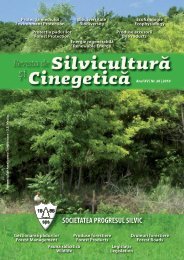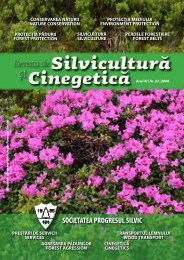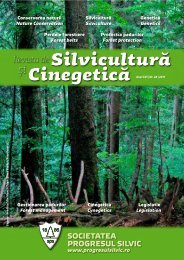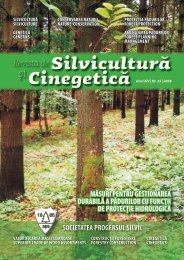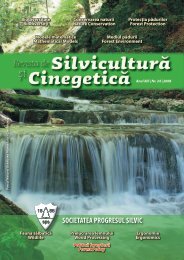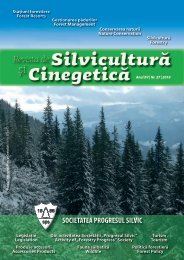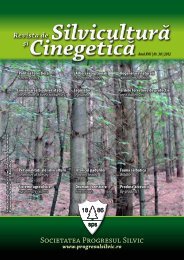Silviculture and Cinegetics Review - Societatea Progresul Silvic
Silviculture and Cinegetics Review - Societatea Progresul Silvic
Silviculture and Cinegetics Review - Societatea Progresul Silvic
Create successful ePaper yourself
Turn your PDF publications into a flip-book with our unique Google optimized e-Paper software.
FORESTRY BELTS SILVICULTURE AND CINEGETICS REVIEW XVII/30/2012<br />
(Steppe)<br />
100 m alt.<br />
Soil reaction (pH) <strong>and</strong> degree of base saturation (V%)<br />
will undergo corresponding changes with the rise in<br />
altitude of the bar of the bioclimatic indicators more<br />
active for vegetation (Maruşca, 2007).<br />
Changes much slower in the soil will cause the<br />
productivity of natural vegetation <strong>and</strong> crops to be quite<br />
low although more favorable conditions of heat will be<br />
in the future in higher elevations.<br />
1.4. Forecast of mountain grassl<strong>and</strong> productivity<br />
As a result of climate <strong>and</strong> soil physic-chemical<br />
properties changes, altitude grassl<strong>and</strong> productivity will<br />
change as to reach a maximum between 1600 <strong>and</strong> 1800<br />
m compared to the current 1000 -1200 m altitude, that is<br />
with 600 m higher (Table 4).<br />
In turn, level of productivity will be lower than the<br />
current one due to the reduction with approx. 45 cm of<br />
soil thickness <strong>and</strong> more pronounced acidity by 0.9 units.<br />
Table 4. Forecast of grassl<strong>and</strong> productivity at an increase of average air temperature by 3 0 C (year 2070)<br />
Possible<br />
Natural grassl<strong>and</strong> productivity<br />
floors<br />
Dry matter production Average Specific Livestock production<br />
(zones) Altitude<br />
(DM) t/ha<br />
grazing consumption weight increase (kg/ha)<br />
after (m) Unfertilized N 100 P 50 K 5 period kg DM/kg Unfertilized N 100 P 50 K 5<br />
decades<br />
0 (days) gain<br />
0<br />
kg/ha<br />
kg/ha<br />
Spruce 2200- 2400 1.8 4.8 100 30 60 160<br />
Spruce 2000-2200 2.3 6.0 115 28 80 220<br />
Spruce + 1800-2000 2.8 7.2 130 26 100 280<br />
Beech<br />
Beech 1600-1800 3.3 7.4 145 24 130 310<br />
Beech 1400-1600 2.8 6.8 160 22 120 310<br />
Sessile oak 1200-1400 2.3 6.2 175 20 110 310<br />
Oaks 1000-1200 1.8 5.6 160 18 100 310<br />
Forest 800-1000 1.3 5.0 130 16 80 310<br />
steppe<br />
Steppe 600-800 0.8 4.4 100 14 60 310<br />
Gradients for 100 m altitude<br />
1800-2400 - 0.25 - 0.6 - 7.5 + 1.0 - 10 - 30<br />
1200-1800 + 0.25 + 0.3 - 7.5 + 1.0 + 5 0<br />
600-1200 + 0.25 + 0.3 + 15.0 + 1.0 + 10 0<br />
Through organic – mineral fertilization with N 100 P 50 K 50<br />
kg/ha on the most productive grassl<strong>and</strong>s of 1600 –<br />
1800 m altitude production increases from 3.3 t/ha DM<br />
to 7.4 t/ha DM (224 %) where after conversion in<br />
animal products can be obtain 310 kg /ha gain in live<br />
weight in an average grazing period of 145 days.<br />
Grazing period ranges between 100 days at 600 - 800 m<br />
altitude due to the dry period, same on the 2200 – 2400<br />
m altitude corridor where there is a shorter vegetation<br />
period. The maximum grazing period of 175 days is<br />
reached at 1200-1400 m altitude. Due to altitude, the<br />
specific consumption per 1 kg gain increases by 1 kg<br />
DM for each 100 m altitude, <strong>and</strong> from 14 kg at 600 –<br />
800 m to 30 kg at 2200 – 2400 m altitude.<br />
Due to the decrease of active temperatures by altitude<br />
<strong>and</strong> the increase of precipitation it is created a heathumidity<br />
balance between 600 <strong>and</strong> 1800 m altitude,<br />
interval where grassl<strong>and</strong> productivity is expressed as<br />
live weight gain remaining constant at about 300 kg /ha<br />
on medium fertilized surfaces. Soil <strong>and</strong> climate<br />
conditions in the mountain area more adverse to<br />
traditional agricultural crops by altitude, requires the<br />
development of better grazing livestock on natural<br />
pastures <strong>and</strong> the practice on a larger scale of agro<br />
tourism, like the Alpine countries.<br />
2. The Iberian agroforestry system (Dehesa)<br />
2.1. Importance <strong>and</strong> evolution<br />
The most famous agroforestry system is the Spanish<br />
dehesa that was established since the Neolithic being<br />
76



